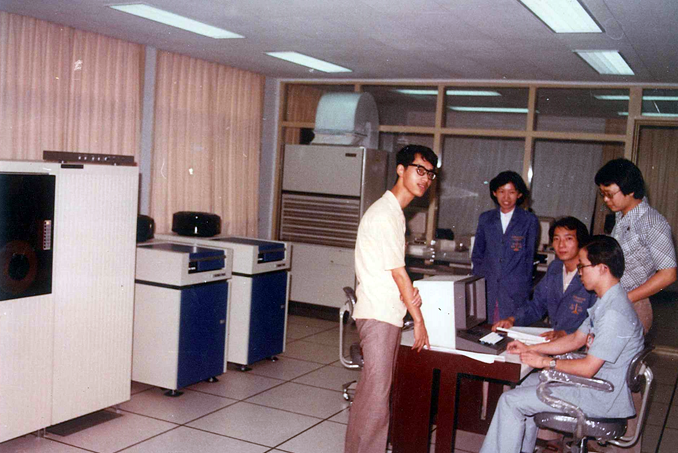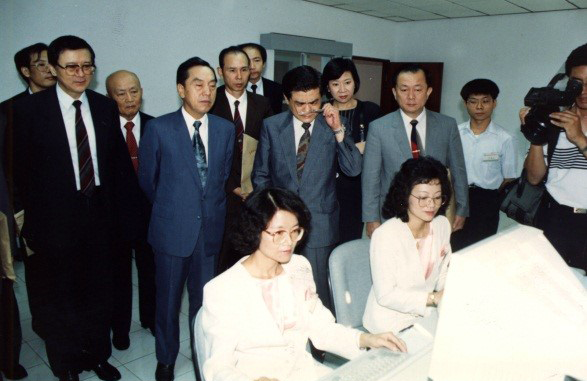The Development and Progress of Taiwan High Prosecutors Office in Promoting Informatization
- Publication Date:
- Last updated:2024-04-19
- View count:1109
1. Established the first information organization of the judiciary (1979 - 1981)
a) The Taiwan High Court Procurators Office established the Criminal Case Information Management Office in 1968, bringing together the criminal information cards as well as the trial rulings and prosecution documents of the courts and prosecutors offices at all levels. As the number of cases had increased year by year, the management and storage of information were becoming more and more difficult, and the search and retrieval thereof were particularly difficult. As a result, the “Electronic Processing Data Project” was proposed for implementation in March 1979.
b) In 1979, Directorate-General of Budget, Accounting and Statistics of Executive Yuan agreed to proceed.
c) The Ministry of Justice approved the establishment of the “Electronic Operation Group (Data Processing Group)” in the “Taiwan High Court Prosecutors Office Data Processing Center” in 1980.
2. Established the Electronic Processing Group of the Data Processing Center of the High Prosecutors Office (1981)
a) Composition
(1) Personnel reporting (May 4, 1981)
In addition to the 30 contract workers hired by the Youth Counseling Committee to recruit technicians (6 were added in May 1982), 8 persons were selected by statisticians and staff of the original data room for a total of 44 staff.
(2) Staff training
The electronic processing center of Directorate-General of Budget, Accounting and Statistics, Executive Yuan was entrusted to train the staffs, hoping to combine technical theory and practice.
(3) Personnel assessment
The Ministry of Justice approved “Guidelines for employing and assessing contract workers by the Data Processing Center of Taiwan High Court Prosecutors Office” in 1983.
b) The use of computer equipment
The first computer host of the judiciary was born (the installation was completed in June 1981)
c) System development
(1) Wanted Persons Inquiry System: In October, 1981, the filing and inquiry screens were completed. By the end of June 1982, 84,440 wanted and revoked information were entered, and there are about 3,000 inquiries per month.
(2) Criminal record data management and verification analysis system: Since January 1982, the records for prosecution, ruling and sentence execution and so on have been inputted into the computer for filing according to the criminal information cards. By the end of June 1982, data of more than 100,000 criminal information cards were inputted, and there are about 3,000 inquiries per month.
(3) Fingerprint Indexing System: Since the system was launched in April 1982, there are an average of 2,800 inquiries per month.

3. Cooperate with the police department to establish a criminal cases database (1983 – 1984)
The data of all criminal information cards were inputted into the computer database.
More than 2,500,000 criminal information cards, rulings and prosecution documents from all levels of courts and prosecutors offices dated back to 1968 were also filed into the computer since 1981. Except for inputting new data the computer at any time, only about 1/10 of the accumulated information from before 1981 had been inputted during the past three years due to the limitation of manpower and equipment. According to this speed, it is expected that it will take 10 years to complete the filing work. Meanwhile, the criminal records have their overall relevance in order to best utilize them, so they must all be inputted into the computer before they can be used flexibly. As a result, the criminal record inquiry needs both computer and manual operations to complete, which doubles the labor and fails to achieve the desired results. Therefore, our office negotiated with the National Police Agency of Ministry of the Interior and reached an agreement with them and work together, using the project budget of more than NT$16 million to hire temporary personnel to compare, merge, categorize and number more than 3 million pieces of information which included the police department’s criminal information cards and the information that we had accumulated. The aforementioned data was inputted separately by the National Police Agency, the Criminal Investigation Bureau and Taiwan High Prosecutors Office. The remaining 1 million pieces of information were entrusted by the police department to the Jongjia company for NT$10 million to input into the system starting from January 1984 and finishing at the end of June. In 1984, the new information about investigation and execution was entered into by our Office. The ruling documents were sorted by our Office before being sent to the police department for them to input and microfilm each of them for filing. The internet network constitutes a complete data file system about transfer, investigation, ruling and execution.
4. Promoting the connection between the prosecutors offices at all levels and the central host computer (1986 – 1991)
Real-time registration of criminal case files and connection to the criminal case database
Since 1986, we promoted to link the prosecutors offices at all levels to the Data Processing Center of the Taiwan High Court Prosecutors Office. By the end of 1989, the connection between all prosecutors offices in Taiwan was completed.
5. Shifted to be affiliated to the Information Center of the Ministry of Justice (March 1, 1988)
After we applied to the Executive Yuan and received approval thereof in January 1988, the electronic processing team of our Data Process Center was shifted to under the Ministry of Justice. The Ministry of Justice Information Center was established, and the Chief of Statistics of Ministry of Justice was appointed to be the chief of the Information Center concurrently. The Planning and Design Group, Computer Operation Group and a Data Management Group were set up under the Information Center. The Taiwan High Prosecutors Office hired its director (in 1991, Information Management Office was established and director was changed to section chief). Hsu Wen-Yuan and Wang Hsiu-yueh, both section chiefs of our Statistics Office, were appointed to concurrently serve as the section chief thereof.
6. Established the Information Management Office of the Taiwan High Prosecutors Office (1991)
a) On October 7, 1991, the Information Management Office of the Taiwan High Prosecutors Office was formally established, and Wei Hong-hua was appointed as the Section Chief. At the same time, he was also sent to the Information Center of the Ministry of Justice to concurrently serve as the director of the Planning and Design Group.
b) In 1992, an operator was added to help make the prosecution documents of our Office as well as assisting the Information Center of Ministry of Justice for the operation of supporting case handling system for the prosecution in the first instance.
c) In 1993, one information manager was hired to concurrently handle the business of Information Center of the Ministry of Justice, planning and maintaining the network connection affiliated to the Ministry of Justice.

7. Develop to record the internal criminal case handling process of prosecutors offices, produce the prosecution documents, and strengthen the information exchange between the prosecutors offices and the courts.
Promotion and implementation of the Supporting Case Handling System for Prosecution (1991 – 1998)
In 1989, after completing the connection of the criminal case data between various prosecutors offices in Taiwan, establishing a criminal case database, and laying the foundation for the criminal case information system, in order to innovate the prosecution operation, improve the performance of case handling, maximize the functions of prosecutors offices, strengthen the convenience service for citizens, and enhance the reputation of the prosecution organization, we decided to develop the “Supporting Case Handling System for Prosecution”. The Taipei District Court Shihlin Branch Prosecutors Office (promoted to Taiwan Shihlin District Prosecutors Offices on July 1, 1995) and Taiwan Tainan District Prosecutors Office was designated for trial run and jointly coordinate the planning and designing according to the scheduled progress. The case acceptance, case distribution, recording of case handling process of prosecutors and clerks, and announcement of case closing were all included into the system, hoping that the system can be completed as soon as possible and then adopted by prosecutors offices across the country.
In February 1991, the Taiwan Shihlin District Prosecutors Office held an exhibition on the subsystem regarding case management of investigation and production of prosecution documents. In October of the same year, the Taiwan Tainan District Prosecutors Office held an exhibition on the subsystem regarding case management of execution and related probation, gun and ammunition controls, bail bond management, file management and so on, and the offices above were receiving praise and admiration from the attendants. In 1992, the Prosecutors Office as above won the Top Ten Outstanding Information Application Award rewarded by the Executive Yuan in public.
After planning and completing the connection of criminal data of various prosecutors offices in Taiwan, establishing the criminal case database, and laying the foundation for the criminal information system in 1989. The “Supporting Case Handling System for Prosecution”, a regional network between the prosecutors offices, was planned to be integrated into the criminal case database of the Criminal Information System in 1990. The planning of integration was completed in 1991, winning the ICT Month Outstanding ICT Elite Award.
8. The Ministry of Justice established the Department of Information Management to run its own information operations.
a) The launching and development of the official document management system of the Taiwan High Prosecutors Office
b) The Taiwan High Prosecutors Office implemented the prosecution case handling system in the second instance and the development.
(1) Since August 1999, the Taiwan High Prosecutors Office has implemented the prosecution case handling system in the second instance. The case acceptance, case distribution, handling and closing of cases were controlled by the computer, and the inputted and filed information can be cited to product various drafts and documents.
(2) Each year, according to the business processing needs, the system functions are continuously updated, and the case handling becomes more automatic, thereby reducing the load of manpower.
(3) In 2007, the outsourcing service to add new functions to integrate and informatize the operation of handling the investigation progress books and filing, and it also added new functions such as document sending and distribution, research, statistics and system maintenance.
(4) In 2008, the outsourcing service to reorganized the system of case acceptance and distribution, and added the function of automatic numbering of sending official documents.
(5) In 2011, the Department of Information Management started uploading electronic files regarding the cases about ascertaining the sentence execution to the courts for their reference. After the court makes its rulings, it would also send electronic files regarding the summary table of ascertain the sentence execution to the criminal case database of Ministry of Justice, so as to improve the inquiry and listing of criminal cases of the prosecution organs.
(6) In 2012, the information system was used to strengthen the handling and internal control of litigation cases.
c) The Taiwan High Prosecutors Office develops its own prosecution business system.
(1) We established “Women and Child Safety Management System” in November 2000.
(2) We established the Criminal Profiteering Crimes Investigation System in February 2001
(3) In November 2005, the “Prosecution affairs exchange zone between the first and second instances” was established to enhance the exchange of working experiences in different prosecutors offices.
(4) The Human Trafficking Control Database System was established in March 2010
d) The approval function of electronic form for the Taiwan High Prosecutors Office was launched.
In April 2003, the approval function of electronic form of the Taiwan High Prosecutors Office was officially launched.
e) Promoted the establishment of computerized systems for inquiry session records of the Taiwan High Prosecutors Office and its district offices.
(1) In May 2010, the “Rules of accessing audio recording files of inquiry session and changing their file numbers” established by the district prosecutors' offices were summarized submitted to the Ministry of Justice for review and implementation.
(2) In February 2011, our office planned the establishment of record computerized system of inquiry session for the second instance (the Taiwan High Prosecutors Office and its district offices) in accordance with to decision by the Chairman of ministry affair meeting, as well as handling the centralized storage operation of digital audio and video files and the integration of outsourcing services.
f) Handling the establishment of our information security management
(1) On December 27, 2009, we obtained BSI International Certification to build an information security use environment.
(2) On March 2, 2017, the Ministry of Justice appointed the Taiwan High Prosecutors Office to handle the introduction of ISMS and passed the third party certification for the 27 prosecutors offices at all levels (except for the Supreme Prosecutors Office). In addition to obtaining the second international certification of BSI on November 3, 2017, our office also assisted Taipei District, New Taipei District and Yilan District prosecutors offices to introduce and certify for ISMS standard.
(3) In June 2017, our office convened the Taipei, New Taipei and Yilan District Prosecutors Offices to establish a task force to discuss the establishment of the ISMS information security management system (including the overall applicable security management documents, risk assessment standards, and standard control procedures) of the prosecutors offices (except the Supreme Prosecutors Office), which helped continue to promote the establishment of 23 other B-level prosecutors offices in 2018 and 2019 years, so as to comprehensively improve the security level of the prosecution authority.
g) Handled the global information websites of the Taiwan High Prosecutors Office and its Intellectual Property Branch.

